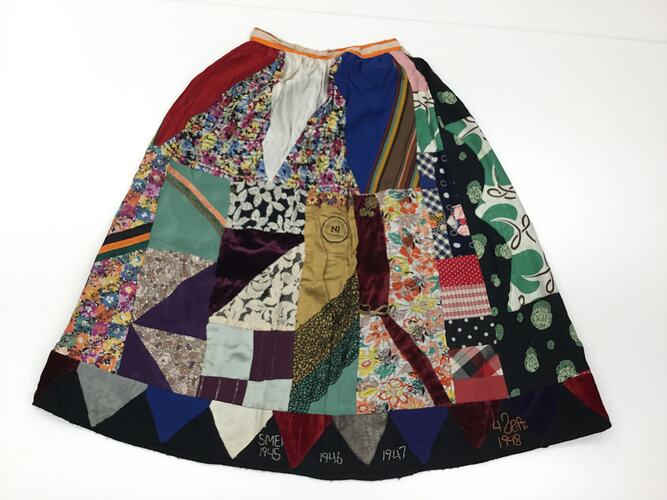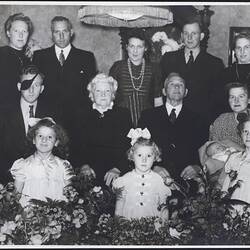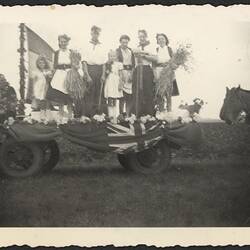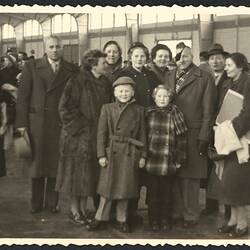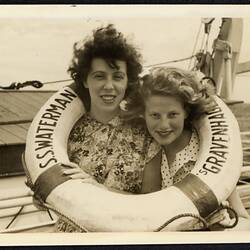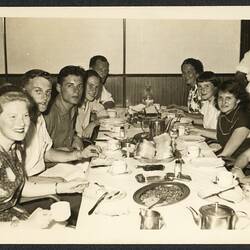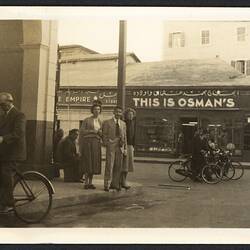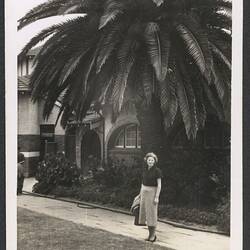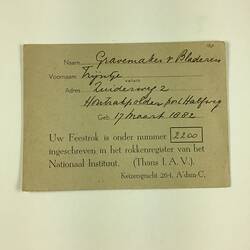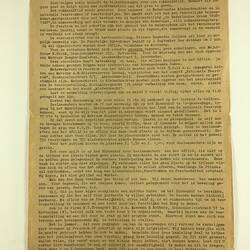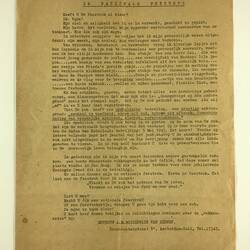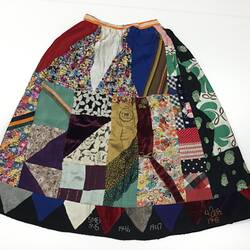This is the story of how a skirt, a symbol of Dutch post-World War II liberation, found its way to Melbourne and is now part of Museums Victoria's state heritage collection.
From The Netherlands to Melbourne:
Trijntje Gravemaker-Van Bladeren was born in 1882 in Sloten, in the province of Friesland in The Netherlands. After her marriage she lived with her husband on the family farm just north of the village of Halfweg and died nearby in Haarlem in 1955. She and her family survived the bitter years of German occupation during World War II.
Tine Roelie Beatrix Gravemaker, Trijntje's eldest granddaughter, was born in The Netherlands in 1936 in Halfweg. Tine migrated to Australia on the ship 'De Waterman', arriving in March 1956, sponsored by a maternal aunt who was working in Sydney at the time. In late 1959, she travelled to London and married her Australian fiance there. They worked in the UK for five years and had their first two children. The family returned to Australia in 1964 and Tine obtained Australian citizenship in 1965. Tine and her family lived in many locations, including Sydney, Melbourne and Adelaide, and she and her husband finally settled in Melbourne in their 80s where Tine died in 2024.
The Feestrok Skirt:
At the end of World War II, Trijntje Gravemaker-Van Bladeren made a Dutch celebration skirt (also called a liberation skirt) on her farm in Halfweg, The Netherlands. It is an adult size skirt but was worn by Trijntje's eldest granddaughter Tine, likely to the annual victory day parades held around the country every year after the war ended in 1945; in this case in Zwanenburg or Halfweg which were the closest villages to the family farm. The registration stamp on the skirt and the accompanying registration card record the year of registration as 1948; and the years of celebration after the War from 1945. The skirt is traditionally created from recycled fabrics to create a patchwork, stitched together on an fabric underlay.
During one of her visits to see her relatives in The Netherlands between 1960-64, Tine was gifted by her paternal aunt Maartje, Trijntje's daughter, the skirt, rosette (to be worn on a white blouse and associated documents (three instruction sheets and a skirt registration card), all also in the Museum's collection. Tine brought the items with her when the family returned to Australia in 1964.
Tine passed the precious skirt on to her eldest daughter, the donor Ingrid Brita Mathew who, in consultation with the family, decided it would be best preserved in the Museum's collection.
The skirt, and the rosette, documents and family photographs, provide a wonderful example of a cultural object transported to Australia by migrants as a treasured heirloom, memory object and national cultural symbol. The photos include the maker and the wearer of the feestrok skirt, and contextualises their migration journey to Australia which eventually resulted in the skirt being brought to Australia as a family heirloom. Having the direct provenance to the maker's family and the official card registering the skirt makes this a unique and precious group of items, and addition to the world distributed collection of feestrok skirts.
This clear provenance to its maker also makes it a more rare international example as it appears there are not many examples in public collections (as at 11/11/24 none found outside of The Netherlands). This item also complements another object already in the Museum's collection: the child's Victory in Europe Day dress in the MV collection, brought by the Hathaways, an English family after World War II as a symbol of celebration and resilience.
History of Feestrok Skirts:
The tradition of the feestrok (celebration) skirt is of enormous cultural significance in The Netherlands and to the Dutch people. The idea for the skirt was evolved by Dutch resistance member Mies Boissevain-Van Lennep, inspired by her wartime experiences when imprisoned in a concentration camp and receiving a patchwork garment made by friends. The patchwork nature of the skirt was developed by a committee of Dutch women to symbolise the rebuilding of post-War Netherlands. In 1947 the feestrok project was set in motion in conjunction with the International Information Centre and Archives for the Women's Movement.
The commemorative skirt had to meet certain conditions in order to be formerly registered as a feestrok skirt. A key condition was the use of repurposed multi-coloured and patterned fabric with a hem of even-sized triangles with the date (in this case) 5 May 1945 and all the subsequent years of national holidays. The skirt was both a national symbol of reconstruction and renewal, but also the personal experiences and memories of the maker.
A skirt would be submitted for registration to one of the rokkencomites (in Amsterdam and also set up in other towns) where it was assessed for authenticity, stamped as authentic and assigned a registration number and a card of registration sent to the maker. The stamp reads: 'Nationale Feestrok' (national celebration skirt), 'Saamgevoegd op één ondergrond' and in the middle 'NI', the abbreviation of National Institute.
Around 4,000 skirts were actually registered - this skirt in Museums Victoria's collection is number 2200 (and likely many more were actually made and worn). Mies Boissevain-Van Lennep had hoped the skirt would become a world-wide phenomenon, as an international symbol of female power, peace and unity. But it appears to have remained a Dutch tradition.
Feestrok seems to be the general term used, with more specific words for these particular skirts including Bevrijdingsrok (liberation skirt) and levensrok (life skirt). It appears there are only a small number in public collections, especially with the associated registration card, making this skirt made by Trijnjte Gravemaker-Van Bladeren and worn by Tine Roelie Beatrix Gravemaker an example of enormous historical and cultural significance.
Skirts in public collections, all in The Netherlands (so far identified), include the Textile Research Centre, Leiden; Rijksmuseum; National Liberation Museum ATRIA Institute on Gender Equality & Women's History; and the Verzetsmuseum (Resistance Museum).
More Information
-
Keywords
-
Authors
-
Article types
